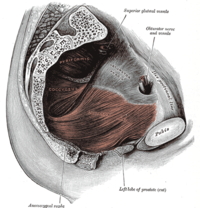
Photo from wikipedia
Introduction/Objectives: Verbal descriptors are an important pain assessment parameter. The purpose of this study was to explore the ability to discriminate deep muscle pain and overlying fascia pain according to… Click to show full abstract
Introduction/Objectives: Verbal descriptors are an important pain assessment parameter. The purpose of this study was to explore the ability to discriminate deep muscle pain and overlying fascia pain according to verbal descriptors and compare the pattern with skin stimulation (from previously published data). Methods: In 16 healthy human subjects, electrical stimulation was chosen to excite a broad spectrum of nociceptive primary afferents innervating the respective tissues. The 24-item Pain Perception Scale (Schmerzempfindungsskala [SES]) was used to determine the induced pain quality. Results: Overall, affective (P = 0.69) and sensory scores (P = 0.07) were not significantly different between muscle and fascia. Factor analysis of the sensory descriptors revealed a stable 3-factor solution distinguishing superficial thermal (“heat pain” identified by the items “burning,” “scalding,” and “hot”) from superficial mechanical (“sharp pain” identified by the items “cutting,” “tearing,” and “stinging”) and “deep pain” (identified by the items “beating,” “throbbing,” and “pounding”). The “deep pain” factor was more pronounced for muscle than fascia (P < 0.01), whereas the other 2 factors were more pronounced for fascia (both P < 0.01). The patterns of skin and fascia matched precisely in sensory factors and on single-item level. Conclusion: The differences in sensory descriptor patterns between muscle and fascia may potentially guide treatment towards muscle or fascia in low back pain physiotherapeutic regimes. The similarity of descriptor patterns between fascia and skin, both including the terms “burning” and “stinging,” opens the possibility that neuropathic back pain (when the dorsal ramus of the spinal nerve is affected) may be confused with low back pain of fascia origin.
Journal Title: Pain Reports
Year Published: 2018
Link to full text (if available)
Share on Social Media: Sign Up to like & get
recommendations!